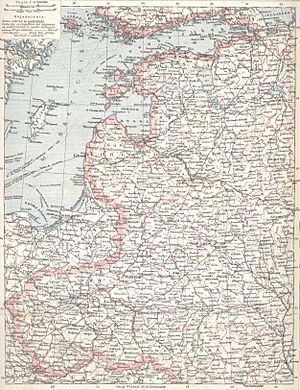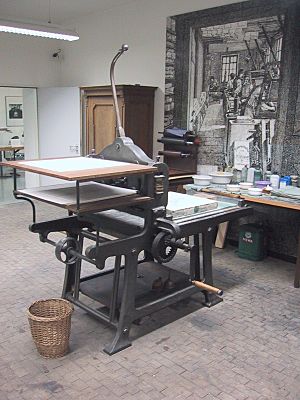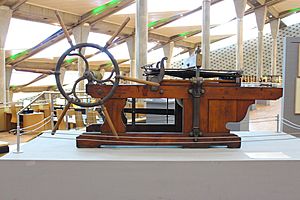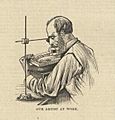Lithography facts for kids
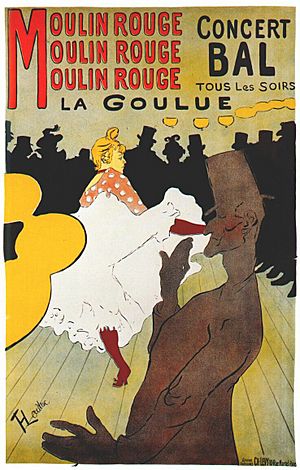
Lithography is a special way of printing pictures or words. It uses a flat surface, like a stone or a metal plate. The word "lithography" comes from Greek words: lithos meaning 'stone' and grapho meaning 'to write'.
This printing method was invented in 1796 by a German writer named Alois Senefelder. He wanted a cheap way to print plays. Lithography can print text or artwork onto paper and other materials.
Contents
How Lithography Works: The Basics
Lithography uses a simple trick: oil and water don't mix!
Imagine drawing a picture on a flat stone with a greasy crayon. Then, you wet the stone. The water sticks to the parts of the stone where you didn't draw. But it runs off the greasy parts where your drawing is.
Next, you roll oily ink over the stone. The ink sticks only to your greasy drawing. It doesn't stick to the wet, non-drawn parts. When you press paper onto the stone, the ink from your drawing transfers to the paper. This creates your print!
In the past, people used smooth limestone for this. That's why it's called "stone writing." Today, flexible metal plates (like aluminium) are often used instead of heavy stones.
Old Way: Printing on Stone

Early lithography used a special stone. An artist would draw on the stone with a greasy crayon or ink. This drawing would be the part that picks up ink later.
After the drawing, a mix of gum arabic and a little acid was put on the stone. This mix made the parts of the stone *without* the drawing "water-loving." This means they would easily get wet. The greasy drawing parts stayed "water-hating."
When it was time to print, the stone was kept wet. The water stuck to the "water-loving" areas. Then, oily printing ink was rolled over the stone. The ink stuck only to the greasy, "water-hating" drawing. It was pushed away by the wet areas.
Finally, paper was pressed onto the stone. The ink from the drawing transferred to the paper, making a print.
Adding Color: Chromolithography
In the early 1800s, people started experimenting with printing in color. A process called chromolithography was developed in 1837. For this, a separate stone was needed for each color!
Imagine printing a picture with red, blue, and yellow. You would need one stone for the red parts, one for the blue, and one for the yellow. The paper would go through the press three times, once for each color. The biggest challenge was making sure all the colors lined up perfectly!
This method was great for posters and images with big, flat areas of color.
Modern Lithography: Offset Printing
Today, lithography is used for printing many things like posters, maps, books, newspapers, and packaging. Most books are printed using a modern version called "offset lithography."
Instead of heavy stones, modern lithography uses thin, flexible plates, often made of aluminium. These plates are covered with a special light-sensitive coating.
Here's how it works:
- Making the Plate: A digital image (from a computer) is used to create the printing plate. Lasers "draw" the image onto the plate's coating. The parts that will print become "ink-loving," and the other parts become "water-loving."
- On the Press: The plate is wrapped around a cylinder on a printing press.
- Water First: Rollers apply water to the plate. The water sticks to the "water-loving" areas (the parts that won't print).
- Ink Next: Then, oily ink is applied. The ink sticks only to the "ink-loving" image areas.
- The "Offset" Part: Instead of printing directly onto paper, the image is first transferred to a rubber blanket cylinder. This is why it's called "offset" printing. The rubber blanket picks up the ink.
- Printing on Paper: Finally, the rubber blanket rolls against the paper, transferring the inked image. This makes sure the image is the right way around on the paper and not too wet.
Modern printing presses can print many colors at once. They can also print on both sides of the paper and use huge rolls of paper for fast printing, like for newspapers.
The invention of desktop publishing and digital cameras made it much easier to prepare images and text for lithography. Now, printing plates can be made directly from computer files, making the process even faster and more accurate.
Images for kids
-
Smiling Spider by Odilon Redon, 1891.
-
Self Portrait with Skeleton Arm by Edvard Munch.
-
An 1836 lithograph of Mexican women making tortillas.
-
Queen Victoria visits HMS Resolute - 1859 lithograph.
-
At Eternity's Gate, an 1882 lithograph by Vincent van Gogh.
-
Sea anemones from Ernst Haeckel's Kunstformen der Natur (Artforms of Nature), 1904.
-
In the Park, Light – George Bellows 1916.
-
Palace of São Cristóvão, the former home of the Emperors of Brazil, a 19th-century lithograph.
See also
 In Spanish: Litografía para niños
In Spanish: Litografía para niños


